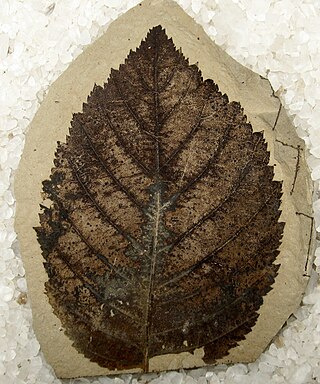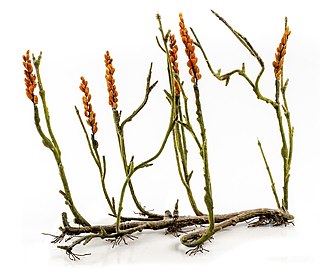
Lycopodiopsida is a class of vascular plants known as lycopods, lycophytes or other terms including the component lyco-. Members of the class are also called clubmosses, firmosses, spikemosses and quillworts. They have dichotomously branching stems bearing simple leaves called microphylls and reproduce by means of spores borne in sporangia on the sides of the stems at the bases of the leaves. Although living species are small, during the Carboniferous, extinct tree-like forms (Lepidodendrales) formed huge forests that dominated the landscape and contributed to coal deposits.

A lichen is a composite organism that arises from algae or cyanobacteria living among filaments of multiple fungi species in a mutualistic relationship. Lichens are important actors in nutrient cycling and act as producers which many higher trophic feeders feed on, such as reindeer, gastropods, nematodes, mites, and springtails. Lichens have properties different from those of their component organisms. They come in many colors, sizes, and forms and are sometimes plant-like, but are not plants. They may have tiny, leafless branches (fruticose); flat leaf-like structures (foliose); grow crust-like, adhering tightly to a surface (substrate) like a thick coat of paint (crustose); have a powder-like appearance (leprose); or other growth forms.

Brown algae are a large group of multicellular algae comprising the class Phaeophyceae. They include many seaweeds located in colder waters of the Northern Hemisphere. Brown algae are the major seaweeds of the temperate and polar regions. Many brown algae, such as members of the order Fucales, commonly grow along rocky seashores. Most brown algae live in marine environments, where they play an important role both as food and as a potential habitat. For instance, Macrocystis, a kelp of the order Laminariales, may reach 60 m (200 ft) in length and forms prominent underwater kelp forests that contain a high level of biodiversity. Another example is Sargassum, which creates unique floating mats of seaweed in the tropical waters of the Sargasso Sea that serve as the habitats for many species. Some members of the class, such as kelps, are used by humans as food.

The embryophytes are a clade of plants, also known as Embryophyta or land plants. They are the most familiar group of photoautotrophs that make up the vegetation on Earth's dry lands and wetlands. Embryophytes have a common ancestor with green algae, having emerged within the Phragmoplastophyta clade of freshwater charophyte green algae as a sister taxon of Charophyceae, Coleochaetophyceae and Zygnematophyceae. Embryophytes consist of the bryophytes and the polysporangiophytes. Living embryophytes include hornworts, liverworts, mosses, lycophytes, ferns, gymnosperms and angiosperms. Embryophytes have diplobiontic life cycles.

Paleobotany, also spelled as palaeobotany, is the branch of botany dealing with the recovery and identification of plant remains from geological contexts, and their use for the biological reconstruction of past environments (paleogeography), and the evolutionary history of plants, with a bearing upon the evolution of life in general. A synonym is paleophytology. It is a component of paleontology and paleobiology. The prefix palaeo- or paleo- means "ancient, old", and is derived from the Greek adjective παλαιός, palaios. Paleobotany includes the study of terrestrial plant fossils, as well as the study of prehistoric marine photoautotrophs, such as photosynthetic algae, seaweeds or kelp. A closely related field is palynology, which is the study of fossilized and extant spores and pollen.

Hornworts are a group of non-vascular Embryophytes constituting the division Anthocerotophyta. The common name refers to the elongated horn-like structure, which is the sporophyte. As in mosses and liverworts, hornworts have a gametophyte-dominant life cycle, in which cells of the plant carry only a single set of genetic information; the flattened, green plant body of a hornwort is the gametophyte stage of the plant.

A microfossil is a fossil that is generally between 0.001 mm and 1 mm in size, the visual study of which requires the use of light or electron microscopy. A fossil which can be studied with the naked eye or low-powered magnification, such as a hand lens, is referred to as a macrofossil.

Equisetidae is one of the four subclasses of Polypodiopsida (ferns), a group of vascular plants with a fossil record going back to the Devonian. They are commonly known as horsetails. They typically grow in wet areas, with whorls of needle-like branches radiating at regular intervals from a single vertical stem.

The Rhynie chert is a Lower Devonian sedimentary deposit exhibiting extraordinary fossil detail or completeness. It is exposed near the village of Rhynie, Aberdeenshire, Scotland; a second unit, the Windyfield chert, is located some 700 m away. The Rhynie chert contains exceptionally preserved plant, fungus, lichen and animal material preserved in place by an overlying volcanic deposit. The bulk of the Devonian fossil bed consists of primitive plants, along with arthropods, lichens, algae and fungi.

The zosterophylls are a group of extinct land plants that first appeared in the Silurian period. The taxon was first established by Banks in 1968 as the subdivision Zosterophyllophytina; they have since also been treated as the division Zosterophyllophyta or Zosterophyta and the class or plesion Zosterophyllopsida or Zosteropsida. They were among the first vascular plants in the fossil record, and had a world-wide distribution. They were probably stem-group lycophytes, forming a sister group to the ancestors of the living lycophytes. By the late Silurian a diverse assemblage of species existed, examples of which have been found fossilised in what is now Bathurst Island in Arctic Canada.

A compression fossil is a fossil preserved in sedimentary rock that has undergone physical compression. While it is uncommon to find animals preserved as good compression fossils, it is very common to find plants preserved this way. The reason for this is that physical compression of the rock often leads to distortion of the fossil.
Microsporangia are sporangia that produce microspores that give rise to male gametophytes when they germinate. Microsporangia occur in all vascular plants that have heterosporic life cycles, such as seed plants, spike mosses and the aquatic fern genus not species Azolla. In gymnosperms and angiosperm anthers, the microsporangia produce microsporocytes, the microspore mother cells, which then produce four microspores through the process of meiosis. Microsporocytes are produced in the microsporangia of gymnosperm cones and the anthers of angiosperms. They are diploid microspore mother-cells, which then produce four haploid microspores through the process of meiosis. These become pollen grains, within which the microspores divide twice by mitosis to produce a very simple gametophyte.

Nematothallus is a form genus comprising cuticle-like fossils. Some of its constituents likely represent red algae, whereas others resemble lichens.

Polysporangiophytes, also called polysporangiates or formally Polysporangiophyta, are plants in which the spore-bearing generation (sporophyte) has branching stems (axes) that bear sporangia. The name literally means 'many sporangia plant'. The clade includes all land plants (embryophytes) except for the bryophytes whose sporophytes are normally unbranched, even if a few exceptional cases occur. While the definition is independent of the presence of vascular tissue, all living polysporangiophytes also have vascular tissue, i.e., are vascular plants or tracheophytes. Extinct polysporangiophytes are known that have no vascular tissue and so are not tracheophytes.
This article attempts to place key plant innovations in a geological context. It concerns itself only with novel adaptations and events that had a major ecological significance, not those that are of solely anthropological interest. The timeline displays a graphical representation of the adaptations; the text attempts to explain the nature and robustness of the evidence.
Orestovia is a lower-middle Devonian thallophyte known from fossilised cuticle, cutinite. Described as an enigmatic taxa, Orestovia has variously been categorised as a brown algae, an algae of unknown affinities, a thalloid non-vascular plant, and an early vascular plant, or even the result of the alternation of generations of some other group.

Tetraxylopteris is a genus of extinct vascular plants of the Middle to Upper Devonian. Fossils were first found in New York State, USA. A second species was later found in Venezuela.
Yarravia is a genus of extinct vascular plants mainly known from fossils found in Victoria, Australia. Originally the rocks in which they were found were considered to be late Silurian in age; more recently they have been found to be Early Devonian. Specimens consist only of incomplete leafless stems, some of which bore groups of spore-forming organs or sporangia which were fused, at least at the base.

Taeniocrada is a genus of extinct plants of Devonian age. It is used as a form genus for fossil plants with leafless flattened stems which divided dichotomously and had prominent midribs regarded as containing vascular tissues. It has been suggested that some species assigned to this genus were aquatic.
This list of 2013 in paleobotany records new fossil plant taxa that were described during 2013, as well as other significant discoveries and events related to paleobotany that occurred in the year.
















